| next curve | previous curve | 2D curves | 3D curves | surfaces | fractals | polyhedra |
LINK
| Other name: interlacing.
Reference: Dale Rolfsen, Knots and Links (1976). |
A link is a finite set of interlaced knots.
More precisely, it is an equivalence class of finite sets of closed curves
of without
double points nor common points, two sets of curves being equivalent if
each curve of one set can be continuously transformed in
into a curve of the other set, the curve remaining closed and without double
points nor common points with any other curve along the transformation.
The crossing number of a link is the minimal number of double points in the planar projections (without points of order greater than or equal to 3) of its representatives. A link a representative of which has a projection without crossings is said to be trivial.
Given two blades in two links, the corresponding sum of the two links is the link obtained by cutting the blade chosen in each link and glueing the edges. A prime link is a link that cannot be the sum of two non trivial links.
Here is the Rolfsen table of the first prime links, with
two or more blades (the symbol
gives the crossing number N, the number of blades n, and
the order number p among the links with N crossings):
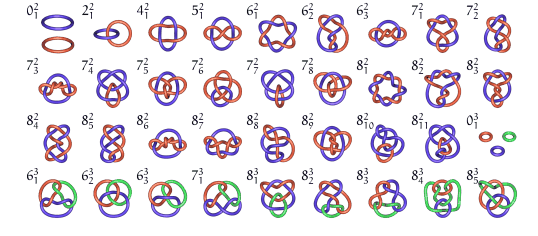
The first six are Pretzel
links.
See also the graph
that enables to encode each link.
More complete table in the knot
atlas.
Examples, with the notation N.n.p (N = crossing number, n = number of blades, p = order number given by Rolfsen):
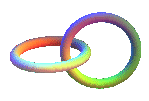 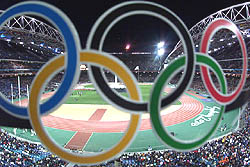 The simplest of links: the Hopf 2.2.1link, that is also the toric solenoid of type (2, 2); the sum of n Hopf links gives a link with n + 1 rings like the link of the Olympic Games. |
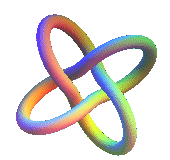 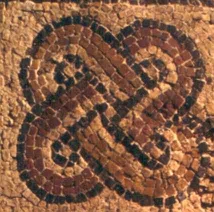  |

Whitehead link 5.2.1 |
  |
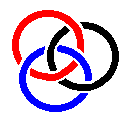
Borromean ring 6.3.2 |
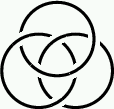 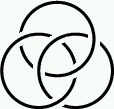 |
See also the Carrick
bend, Brunnian links, that
become trivial when we get rid of one of the components,
billiard
links, the Turk's
heads, Pretzel links, linear
celtic knots, the link of the icosidodecahedron,
the Seifert surfaces,
that fill a link, Antoine's
necklace, that is the limit of a sequence of links.
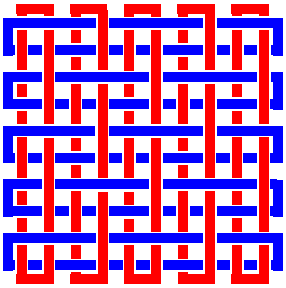 |
Notice that the weave on the left is in fact a trivial link. By the way, it is the reason why it can be made with crepe paper without tearing it! |  |
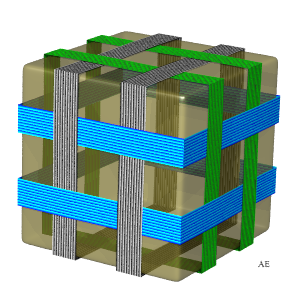 |
This cube strapping forms an link of 6 loops end 24 crossings
that is linked to the rhombicuboctahedron.
On the right, two flat versions of the same link; notice the symmetry of order 4 for one, and 3 for the other one. |
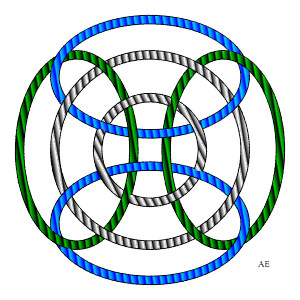 |
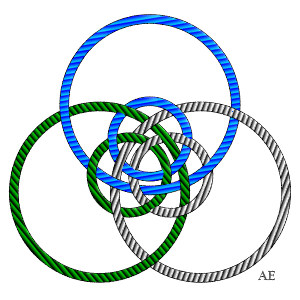 |
Web links:
List of prime links : katlas.org/wiki/The_Thistlethwaite_Link_Table
Java applet that determines the Gauss
code of a link from its drawing: knotilus.math.uwo.ca/javasketch.php
Website that finds a prime link from its Gauss
code: knotilus.math.uwo.ca
Christian Mercat's website, to learn to create your own links www.entrelacs.net
Geraud Bousquet's software to
draw links from a graph
www.math.utk.edu/~morwen/index.html
www.clanbadge.com/knots.htm
stained
glass window in the Aubazine abbey
mathouriste.canalblog.com
| next curve | previous curve | 2D curves | 3D curves | surfaces | fractals | polyhedra |
© Robert FERRÉOL 2019